Microsoft Surface Pro Review
by Anand Lal Shimpi on February 5, 2013 9:00 PM ESTDisplay: Awesome if Calibrated
Surface RT used a 10.6-inch 1366 x 768 display, for Surface Pro Microsoft integrated a full 1920 x 1080 panel of the same size. The increase in resolution is appreciable and you definitely notice it when switching between the two Surface models. Pixel density isn’t class leading, but it’s at least in the right range. On the desktop, Microsoft enables 150% DPI scaling by default which makes everything legible but still a bit odd in applications that don't deal well with fractional DPI scaling. Ideally I would've liked to have seen a clean doubling to avoid this mess.
The higher res display just makes everything sharper in the modern UI, and the 150% DPI scaling in desktop mode makes everything big enough where the higher res isn't a problem there. It's only in those desktop applications that don't properly implement Windows DPI scaling where the higher resolution is a hindrance. I actually ran into this problem using Chrome on the desktop, where my taps wouldn't always map to the right parts of the application (not to mention that Chrome in DPI scaled Windows looks terrible). Thankfully there is always the pen...
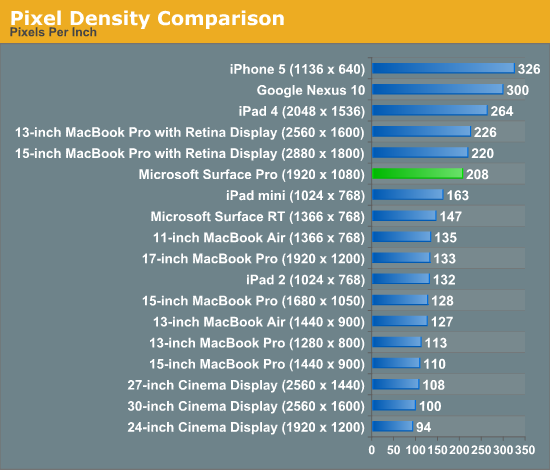
Once again Microsoft doesn’t do any substantial color calibration at the factory, but unlike on Surface RT you can run your own Windows display calibration software on Surface Pro to improve color accuracy if you have the right equipment.
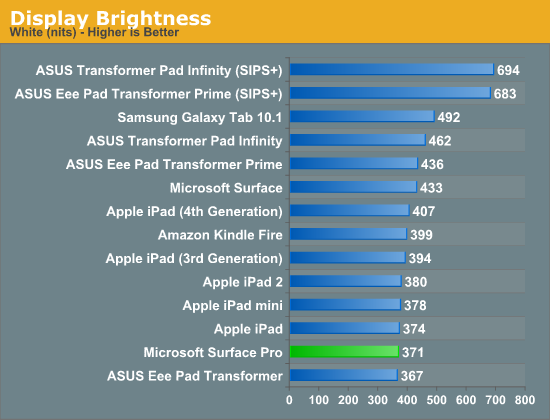
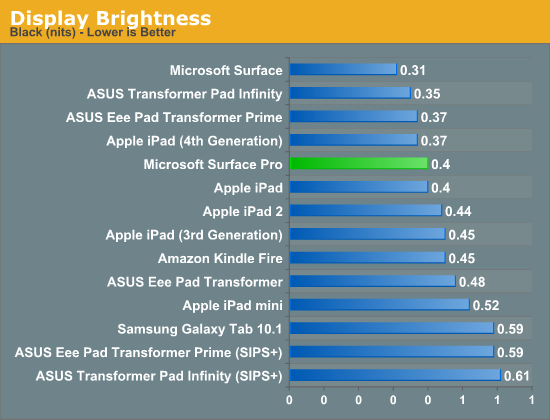
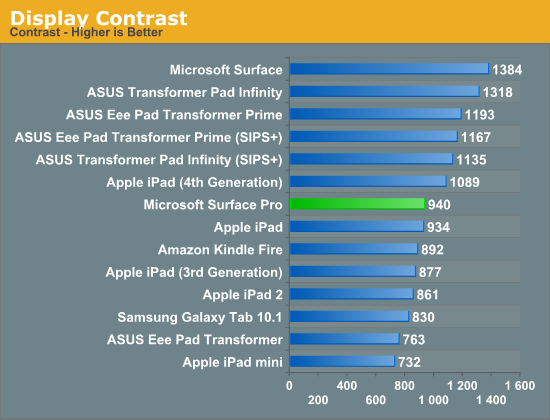
Out of the box my Surface Pro sample had an unusually high white point (~7500K), which negatively impacted its grayscale accuracy. To evaluate color accuracy I turned to our own Chris Heinonen's CalMAN smartphone/tablet workflow. Color accuracy is near identical to Surface RT, which is to say that it’s ok compared to PC notebooks from a couple of years ago but still far behind what you get out of the box from Apple.
Given that the majority of users don’t do any color calibration on their PCs, this becomes a real problem for consumer perception if your tablet doesn’t ship with accurate colors by default.
To see what the panel is capable of I ran it through our standard PC display calibration routine (which I can do since it’s running Windows 8 and is effectively a PC). I then re-ran it through our CalMAN smartphone/tablet workflow and ended up with much more pleasing results. While the display still lagged behind the iPad in one of the tests, it bested Apple’s Retina Display in the other two color accuracy benchmarks.
We'll start off by looking at the calibrated white point for these tablets. What you're looking for here is a number close to 6500K:
The next three charts look at accuracy represented as a difference between various source colors and what's reproduced on the display. The results are presented as average dE2000, with lower numbers being better.
First up is Grayscale performance, here we're looking at the accuracy of black, white and 19 shades of gray spread in between the two extremes:
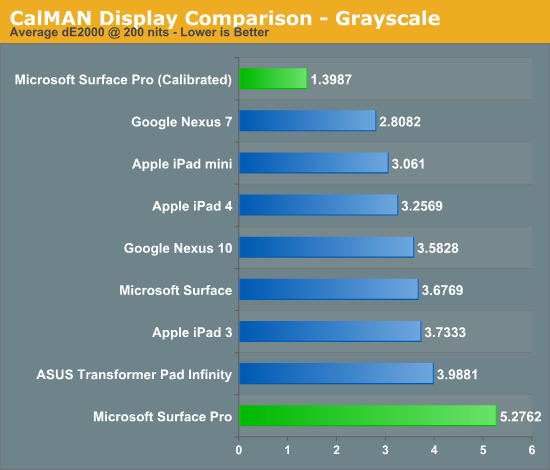
Out of the box grayscale performance is abysmal on Surface Pro. Calibrated accuracy, on the other hand, is just awesome.
First in our color accuracy tests is a saturation sweep. Here we're looking at 20%, 40%, 60%, 80% and 100% saturations of red, blue, green, magenta, yellow and cyan.
Our saturation sweep is the only test where even a calibrated Surface Pro can't match the iPad, it does do a lot better than Surface Pro without any color calibration however. Out of the box Surface Pro is considerably worse than any Apple tablet.
Gamut CIE Chart

Saturation CIE Chart
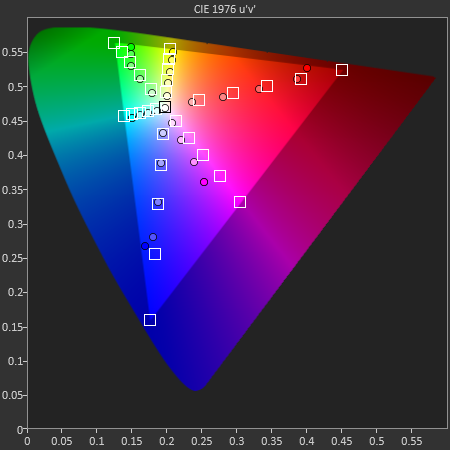
For our final accuracy test we're looking at the difference between a Gretag Macbeth colorchecker chart and the rendered swatches on these displays. Once again, lower numbers are better.
Out of the box Surface Pro and Surface RT are near identical here, and similar to the Nexus 10. With a good suite of calibration tools and supported hardware under Windows 8, Surface Pro has the potential to easily outperform the iPad if given the opportunity.
GMB Color Checker
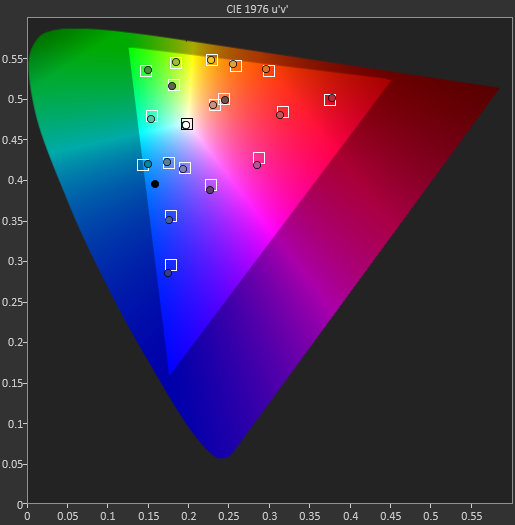
Surface Pro’s panel has real potential, it just needs a calibration pass - which is honestly something Microsoft should be doing these days, not the end user.
Mini DisplayPort but No Thunderbolt
Surface RT featured a single video output in the form of a micro HDMI port. Surface Pro adopts a mini DisplayPort output instead, and will have adapters to enable DVI and HDMI support.
The miniDP output immediately activates as soon as you plug a display into it. I sometimes had issues with display resolutions being set sub optimally, but generally speaking the process was as plug and play as you can get.
I did notice some visual tearing on the Surface Pro display when connected to an external HDMI monitor, similar to what I saw with Surface RT but not nearly as bad. I’m beginning to think something is a bit wonky with Windows 8’s multi-monitor support. What’s interesting is I didn’t see the issue on all displays, which is more than I can say for Surface RT. Update: It looks like this is hardware related. Even if the internal and external panels have the same refresh rate, Intel's HD 4000 won't guarantee that the refreshes will happen at the same time - which is why we see tearing. The tearing should only be present in clone mode, not extended desktop (I'll verify this shortly). It seems like Tegra 3 is worse in this regard, which is why the issue was so much more prevalent on Surface RT. I need to check other Ivy Bridge platforms and under OS X to see if the problem is as prevalent there as well.
The only disappointment here is Microsoft opted against integrating Thunderbolt into Surface Pro. I feel like Thunderbolt would’ve made a ton of sense in a device like Surface Pro, enabling one cable connection to both an external display and high-speed external storage. Given that Thunderbolt adoption remains fairly limited in the PC space I don’t think this is a huge loss for most of Microsoft’s target customer base, but I do feel like it’d be a good way of future proofing the device. The alternative that Surface Pro offers is the combination of miniDP and USB 3.0, which realistically speaking is probably good enough for most users. From a cost of integration standpoint vs. the number of users who would pay for it, it probably didn’t make sense for Microsoft to include Thunderbolt in Surface Pro, but that doesn’t change the fact that I wish it was there. It’d be nice for Apple not to be the only company really pushing Thunderbolt.
Camera Quality
Surface Pro, like Surface RT before it, features two integrated 720p cameras with no flash. Admittedly I didn't spend a ton of time taking photos with Surface Pro but imaging quality is just really bad compared to what you'll get out of an iPad 4. The results are borderline ok for use on the web but that's pretty much it, and forget about decent low light performance.


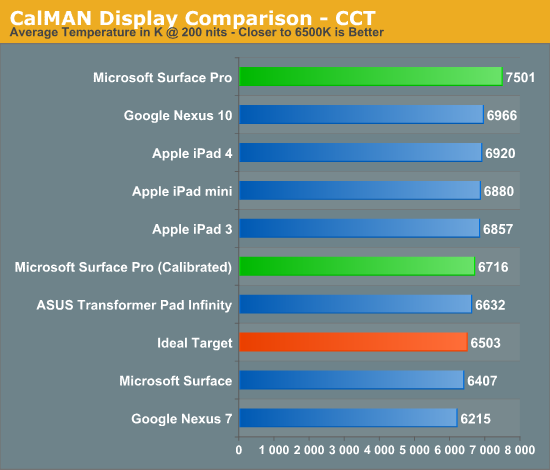
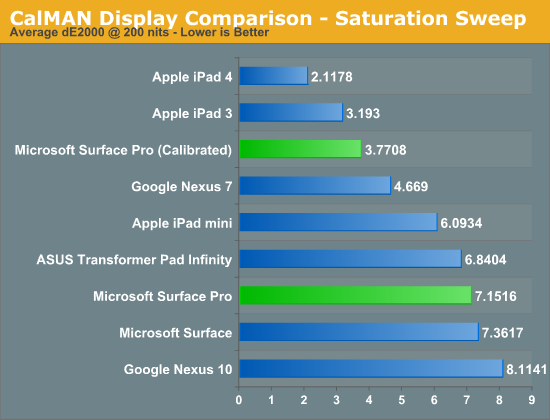
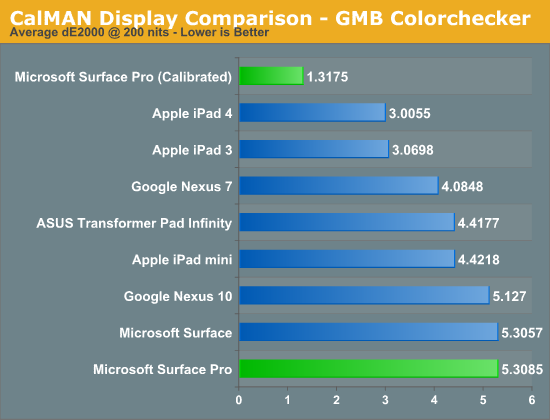










228 Comments
View All Comments
netmann - Thursday, February 7, 2013 - link
Nice review Anand! It seems there is a lot of interest on this device. If you still have the unit can you please do a quick tear-down of the unit with pictures showing the cooling fans, SSD, memory, etc?Wolfpup - Thursday, February 7, 2013 - link
Fantastic review!Random thought I've had about Surface since it was unveiled...doesn't a keyboard dock like what HP includes with their Envy x2 make more sense than these touch/type covers?
I mean I get that some people use covers anyway, and leave them on (I don't on my iPad 2), and so you're sort of getting a keyboard always there for "free" for those people.
But at least judging by pictures, the touch and even type covers appear to be terrible keyboards, and look really awkward. The kickstand is nifty, I guess, but HP's Envy x2 (and some others) are basically giving you a normal notebook keyboard you plug it into, and it becomes almost indistinguishable from a notebook. That gives you a better keyboard, unlimited angles to put the screen at, and also makes it easier to sit it on your lap and type, if need be.
I haven't used either type of device yet, but from pictures it sure seems like a dock like that would be preferable to a type cover/pad?
This really is an interesting product though...I thought Apple needed to do this 4 years ago, like in place of what the iPad turned out to be, I was hoping it would be a real OS X PC running on Atom with an optional touch interface-basically exactly what Windows 8 ended up being.
I know these will get massively better even later this year with Haswell (or heck, Tegra 4), but I'm still so tempted both by Surface Pro and that Envy x2... (wish that used AMD's Z60 instead of Atom though). Hmm...an additional battery in a keyboard dock could double Surface Pro's battery life too...
And yeah, to me it seems like this ought to come with a type cover. I can understand and accept the price-this is an actual PC running hardware that runs circles around an iPad that's only marginally cheaper-but somehow it just seems like these things should be including keyboards.
TidalWaveOne - Thursday, February 7, 2013 - link
"f you’re shopping for an Ultrabook today and want that tablet experience as well, Surface Pro really is the best and only choice on the market."There is at least one other device for that ultrabook/tablet experience... the Dell XPS 12. I have one on order... there are also more, like the Lenovo Yoga.
Death666Angel - Thursday, February 7, 2013 - link
Different designs in my opinion. The Dell has the burden of always carrying around that keyboard, which means you have a 1.5kg tablet. The CPU, RAM and storage options look pretty good on that. But it lacks a digitizer which might or might not be a huge deal for you. Same thing with the Yoga. Very big (13.3"), low-ish resolution (900p), always a keyboard attatched, no active digitizer. Again, these things might be important enough to make the devices pretty much distinct categories. Or you just want "laptop-ish, touch screen, Core CPU" then they are all comparable. :DThe closest things to the Surface Pro in my mind are:
- Lenovo Helix: 11.6", 1080p, keyboard dock, active digitizer, 3G
- Samsung Ativ PC Pro: 11.6", 1080p, keyboard dock without battery, active digitizer, 3G
With the Lenovo being my dream device, because of the battery built into the keyboard dock mostly. But the dock design is fairly cool, too. :D
travelster - Thursday, February 7, 2013 - link
Almost two years ago I picked up an ASUS EP121 10 inch Tablet. It came with an i5 processor and Windows 7. I now have Windows 8 on it. Win 7 and 8 runs extremely well, as does Word, MS Project, VMWare, RDP, and all other apps I can run on Windows desktops and laptops. I.e. The Surface Pro's grand vision of a full-service Windows tablet was old news even before long it was released!Glenn Rogers
DBGallery Product Manager
sn_85 - Thursday, February 7, 2013 - link
After playing around with this at the Microsoft Store today I came away feel like it was a mixed bag. I feel the build quality is really impressive and I have no qualms about the unusual nature of it's kickstand and keyboard covers. It just feels like a wonderfully solid design that takes on a more business like approach with it's VaporMg and straight line design. Honestly I just wish it came in the form factor of the Surface RT because what a difference a half pound and 3.5mm can really make. The thick form factor and weight just make it much more cumbersome to hold and I wouldn't see myself holding this thing in one for two long at all. Before anyone calls me a weight weenie you really just have to hold it in person and compare the Pro the RT before make a statement, it's a pretty significant difference. I hope the next iteration takes on a diet and comes closer to the form factor of the Surface RT because it still retains the impressive build quality without all the thickness and weight.Battery of course is another area of concern. If this thing got closer to 6-7 hours like some of the longer lasting Ultrabooks it would be a real winner IMO.
The price I feel is fine but the keyboard covers need to be included in the price. I know it's a unique design but there is no reason for MSFT to be nickel and diming here, especially in the case of the Pro. Fact is anyone looking at this device will buy either one of the Touch or Typecovers but to just spend another $120-$130 on it is excessive.
Ultimately I think this device is what most reviews say, you can see the tremendous potential and it is impressive in it's own right. It just misses on a few key things that keep it from being a product that is universally recommended as opposed to what it is right now where you need to know what you're getting into. I feel just like Anand on this, the Surface Pro 2 is simply going to be an awesome product. One that I'd buy on launch day. That being said I still might get this Surface Pro until that time comes.
sirnumbskull@gmail.com - Friday, February 8, 2013 - link
Can you verify whether or not the Surface Pro has Widi support?Kornfeld - Friday, February 8, 2013 - link
WiDi is an Intel technology that requires, among other things, supported Intel WiFi adapters. Since Surface Pro uses a Marvell WiFi adapter, it cannot possibly use WiDi.The real question is whether it will support Miracast which is the larger spec being adopted by the WiFi alliance. I'm not sure if that specific adapter supports Miracast. I found this press release, but I'm not sure about the part numbers: http://www.marvell.com/company/news/pressDetail.do...
The bigger problem with Miracast right now is that there doesn't seem to be any connection software available for Windows. So, I'm sitting around with a Yoga that has a Miracast supported WiFi adapter and I have the latest Netgear device that supports WiDi and Miracast, but no application that can be used to connect to the device.
toyotabedzrock - Friday, February 8, 2013 - link
Looking at the pictures it becomes apparent that they did not pay enough attention to small details. The random 5 pin connector looks ripe for problems. And sticks out like a soar thumb.The display resolution is too low on both models. And there is no excuse for the small batteries.
It seems as if the execs at these PC companies eyes are failing them if they have not noticed these things.
redSn0w - Friday, February 8, 2013 - link
Just wondering if Microsoft could have gotten better battery life by using a Core i3 or even some pentium/celeron derivative. The way i see it, the 3 main drawbacks are the price, battery life and thickness/weight of device. So, maybe using one of the aforementioned processors for the first generation product would have helped. And, they could have moved to Core i5 when Haswell started shipping.I seriously doubt that any power user could replace their notebook/desktop with a Surface pro unless you could dock it to a bigger screen and a proper keyboard. As for the regular users i don't think too many of them would even be interested in a product like this when an iPad works for them.
Anyways, i'm still going to go check it out tomorrow but most likely i'll wait for the next generation product (if it's ever released).